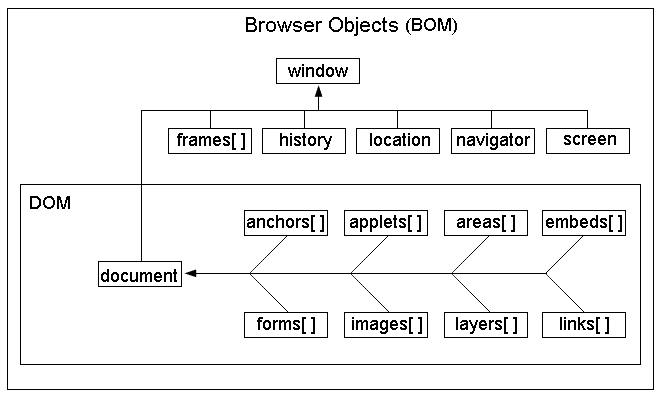• BOM(browser object model)浏览器对象模型
1.BOM的介绍
JavaScript基础分为三个部分:
- ECMAScript:JavaScript的语法标准。包括变量、表达式、运算符、函数、if语句、for语句等。
- DOM:文档对象模型,操作网页上的元素的API。比如让盒子移动、变色、轮播图等。
- BOM:浏览器对象模型,操作浏览器部分功能的API。比如让浏览器自动滚动。
BOM:Browser Object Model,浏览器对象模型。
BOM的结构图:
由上图可知:
window对象是bom的顶层对象,所有对象都是通过它延伸出来的,也可以成为window的子对象
dom是bom的一部分
window对象:
- window对象是JavaScript中的顶级对象。
- 全局变量、自定义函数也是window对象的属性和方法
- window对象下的属性和方法调用时,可以省略window
1.window对象的方法—屏幕弹窗
语法:window.alert()语法:window.confirm("msg")语法:window.prompt("msg") //提示
1.1.1window.alert()
var btn=window.alert(1)
1.1.2window.prompt(“msg”)
var res=window.prompt("请输入你的名字")console.log(res)
1.1.3window.confirm(“msg”)
var isDelete= window.confirm("你确定删除吗");if(isDelete){//parentNode -->亲爸btn.parentNode.style.display="none";}
1.2.window对象的方法—定时器
1.2.1setTimeout—延时调用
<script>//setTimeout 超时调用 间隔一段时间,执行函数,且只执行一次console.log(1)setTimeout(function(){console.log("a")},1000)console.log(2);//输出结果1 2 a</script>
1.2.2setInterval—间隔调用
<script>//间歇调用 间隔一段时间,执行函数setInterval(function(){console.log("b")},3000)</script>
例子
<script>/* setInterval递归 在函数中调用函数自身 */function go(){setTimeout(function(){console.log("hello world")go()},1000)}go()</script>
//每秒输出一个数字 0-3 到3的时侯结束输出<script>var a=0;function go(){setTimeout(function(){console.log(a);a++;if(a<=3){go();}},1000)}go();</script>
1.2.3清除定时器
clearInterval()
<button id="btn">btn</button><script>var btn=document.getElementById("btn");var timer=setInterval(function(){console.log("a")},3000)//清除定时器 clearInterval()console.log(timer)btn.onclick=function(){clearInterval(timer)}</script>
1.3.window.open()—打开新的浏览器页面
<!-- 打开新的浏览器页面 --><button id="btn">打开http://www.baidu.com</button><script>btn.onclick=function(){window.open('http://www.baidu.com')}</script>
2.location对象
location对象提供了与当前窗口中加载的文档有关信息,还提供了一些导航的功能,他既是window对象的属性,也是document对象的属性。
location.href与window.location.href等价语法:location.hash功能:返回URL中的hash(#号后跟0或多个字符),如果不包含则返回空字符串语法:location.host功能:返回服务器名称和端口号语法:location.hostname功能:返回不带端口号的服务器名称语法:location.pathname功能:返回URL中的目录和(或)文件名语法:location.port功能:返回URL中指定的端口号,如果没有,返回空字符串
3.history对象
history对象保存了用户在浏览器中访问页面的历史记录语法:history.back()功能:回到历史记录的上一步相当于是用了history.go(-1)//-1表示前一步,-2前两步语法:history.go(1)功能:回到历史记录的前一步相当于history.forward()语法:history.go(-n)功能:回到历史记录的前n部语法:history.go(n)功能:回到历史记录的后n步
例子
1.返回历史记录的前一个页面 index.html
<a href="detail.html">detail</a><button id="btn">返回detail页面</button><script>var btn=document.getElementById("btn");btn.onclick=function(){/* 返回历史记录的前一个页面 */history.forward()}</script>
2.回到历史记录的上一个页面 detail.html
<button id="btn">跳转到index.html</button><script>var btn =document.getElementById("btn");btn.onclick=function(){history.back()}</script>
4.navigator对象
1.掌握Navigator对象的userAgent属性2.掌握如何判断浏览器的类型3.掌握如何判断设备的终端是移动还是PCUserAgent:用来识别浏览器名称,版本,引擎以及操作系统等信息的内容。//检测浏览器类型if(/Android|iphone|webOS/i.test(navigator.userAgent)){location.href="mobile.html"}else if(/ipad/i.test(navigator.userAgent)){location.href="pad.html"}
5.screen对象
screen对象包含有关客户端显示屏幕的信息screen.availWidthscreen.availHeight

